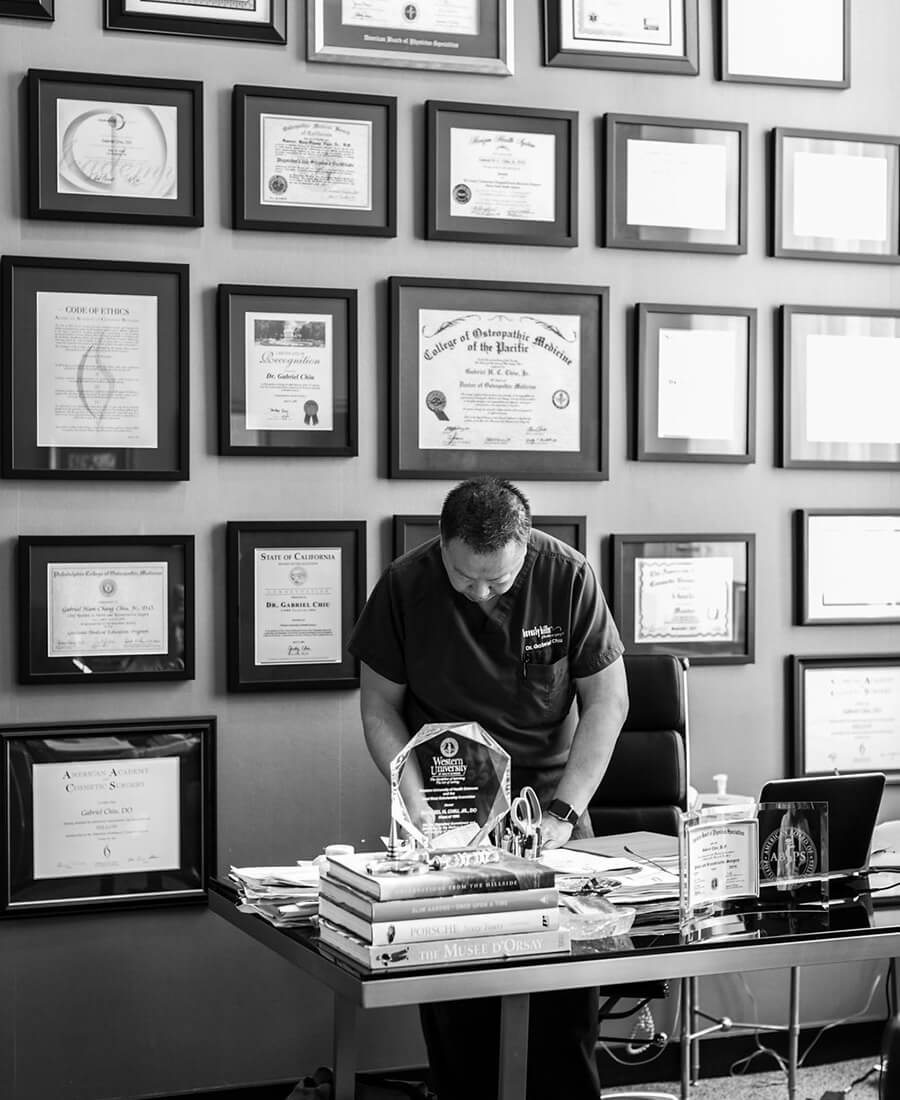Breast Reduction in Beverly Hills, CA
Breast reduction, also known as reduction mammaplasty, is a surgical procedure that removes breast tissue. This type of breast augmentation is designed for women with large, pendulous breasts who experience medical problems caused by excessive weight and low center of gravity in their breasts, ranging from back, shoulder, and neck pain and skin irritation to skeletal deformities and breathing problems.
Disproportionately large and heavy breasts may also diminish a woman’s sense of self-esteem and independence, as they make fitting into clothing, participating in sports, and other activities more difficult. A breast reduction removes fat, glandular tissue, and skin from the breasts, making them smaller, lighter, and firmer. It can also reduce the size of the areolas, the darker skin surrounding the nipple. The goal is to give the patient smaller, better-shaped breasts in proportion with the rest of her body.
If you are considering a breast reduction, we invite you to call our office at (310) 888-8087 to schedule a consultation with Dr. Gabriel Chiu in Beverly Hills. Together, we you can determine which techniques are right for you.

Table of Contents


What Can a Breast Reduction Achieve?
Smaller Breasts
As fat and breast tissue are removed, excess skin is also neatly trimmed away to reveal lighter, tighter breasts.
Resized Areolas
Oversized areolas can be addressed by reshaping them and lifting their location on the breasts.
Improved Body Proportions
Breast reduction surgery is designed to help women feel more secure in their bodies by reducing the size of enlarged, uncomfortable breasts.
What Will My Breast Reduction Procedure Entail?
Dr. Chiu will evaluate your body type and determine a recommended surgical plan to achieve your ideal outcome.
Anesthesia
Your breast reduction may be performed in an outpatient surgical center, a surgical suite, or in a hospital setting. If you are admitted into the hospital, then your stay should be brief. The surgery itself usually takes three to four hours, but may take longer in some cases. Breast reduction is performed under general anesthesia, which means you’ll be asleep through the entire operation.
Technique
Personal preferences, cosmetic goals, and other factors will determine the specific method selected to reduce the size of your breasts. Incisions are most commonly created in the anchor-shaped technique, which circles around the areolas, extends downward on the breast, and follows along the natural curves of the breast crease (where the breast meets the chest wall). With this method, Dr. Chiu removes breast tissue, excess fat, and loose skin. The nipples and areolas are then moved to their new position, and the skin is pulled in from both sides of the breast down and around the newly formed areolas. This process allows him to reshape the new contour of the breasts. Liposuction may be used to remove additional excess fat.
In most cases, the nipples remain attached to the nerves and blood vessels. However, if the breasts are significantly large, the nipples and areolas may be removed entirely and replaced in a higher position through grafting. If this is necessary, it will result in a loss of sensation in the nipples and areolar tissue. Stitches or sutures are placed around the areola in a vertical line extending downward, along the lower crease of the breast. Some techniques can be utilized to eliminate the vertical portion of the scar.
When only the excess fat needs to be removed, liposuction may be used to reduce the breast size, which results in minimal scarring.
Sometimes, a breast reduction also includes a breast lift (mastopexy) to raise the breasts on the chest and reduce sagging. If you are explanting breast implants through removal or en bloc, then you may choose new breast implants or opt for natural breast tissue.

What Can I Expect During My Breast Reduction Recovery?
The recovery timeline can vary for each patient, varying with factors like age, natural recovery speed, and complexity of the surgery. Dr. Chiu will provide you with a personalized timeline during your consultation based on these factors. However, a general outline can include:
Immediately After
Directly after your surgery, you’ll be wrapped in an elastic bandage or a surgical bra over gauze dressings. A small tube may be placed in each breast to drain out blood and fluids for the first day or two. You may feel some pain for the first couple of days, specifically when you move around or cough, and some discomfort for another week or more.
Dr. Chiu will prescribe medication to lessen the pain. The bandages will be removed a day or two after surgery, though you’ll continue wearing the surgical bra around the clock for several weeks until the swelling and bruising subside. If your breast skin is very dry following surgery, you can apply a moisturizer several times a day, but be sure to keep the suture area dry.
1 Week
You should be feeling much better after one week. Most symptoms should begin to fade by this point. Dr. Chiu will give you detailed instructions for resuming your normal activities. Most women can return to work (if it’s not too strenuous) and social events in about one to two weeks.
2 to 3 Weeks
Your first menstruation following surgery may cause your breasts to swell and hurt. You may also experience random, minor pains for a few months. You can expect some loss of feeling in your nipples and breast skin, caused by the swelling after surgery. This usually fades over the next six or so weeks. In some patients, however, it may last a year or more, and sometimes it may be permanent. Although you may be up and about in a day or two, your breasts may still ache occasionally for a couple of weeks. You should avoid lifting or pushing anything heavy for three or four weeks.
4 to 6 Weeks
You can expect to have much less stamina for several weeks and should limit your exercises to stretching, bending, and swimming until your energy level returns. You’ll also need a good athletic bra for support. You may be instructed to avoid sex for a week or more since sexual arousal can cause your incisions to swell, and to avoid anything but gentle contact with your breasts for about six weeks. A small amount of fluid draining from your surgical wound, or some crusting, is normal. If you have any unusual symptoms, such as bleeding or severe pain, don’t hesitate to call Dr. Chiu or any members of the Beverly Hills Plastic Surgery® staff. Discomfort usually dissipates after four weeks.
What Results to Expect After Breast Reduction Surgery in Beverly Hills
Although much of the swelling and bruising will disappear in the first few weeks, it may be six months to a year before your breasts settle into their new shape. Even then, their shape may fluctuate in response to your hormonal shifts, weight changes, and pregnancy.
Dr. Chiu is skilled in making scars as inconspicuous as possible. Breast reduction scars can be extensive and are permanent, and often remain lumpy and red for months, and then gradually become less obvious. Sometimes scarring eventually fades into a thin white line. Fortunately, the scars can usually be placed inconspicuously so you can wear low-cut tops without noticing them.
Out of all available plastic surgery procedures, breast reduction can result in the quickest body-image changes. You’ll be relieved of the physical discomfort of large breasts, your body will look more proportioned, and clothes will fit you better.
As much as you may have anticipated and desired these breast changes, you will require time to adjust to your new appearance, as will your family and friends. Be patient with yourself and with your loved ones, and remember why you had this surgery. Almost all patients are pleased with their results.
Why Choose Dr. Chiu?
Dr. Chiu is a board-certified plastic surgeon and is known as the “Curve Creator” with extensive skill and experience in performing breast reductions.
With an artful eye for aesthetics and medical knowledge to help patients achieve their desired results, he is a qualified surgeon and offers many procedure options to all of his patients. Patient safety, satisfaction, and comfort are the top priorities of Dr. Chiu and his professional staff.
Frequently Asked Questions About Breast Reduction

At what age can I get breast reduction surgery?
While there is no age limit for undergoing breast reduction, it’s generally recommended that you wait to get surgery after breast development is complete—usually around age 18. However, exceptions can be made in certain cases.
Am I a candidate for breast reduction surgery?
Breast reduction surgery is usually performed for physical relief rather than simply cosmetic improvement. Most women who have the surgery are troubled by very large, sagging breasts that restrict their activities and cause them physical discomfort. In most cases, breast reduction isn’t performed until a woman’s breasts are fully developed; however, it can be done earlier if large breasts are causing serious physical discomfort.
The best candidates are those who are mature enough to fully understand the procedure and have realistic expectations about the results. Traditionally, breast reduction is not recommended for women who intend to breastfeed. To learn more about breast reductions and whether you are a candidate for this procedure, please get in touch with us online by filling out our contact form.
Is a breast reduction painful?
The surgery itself is not painful, as it is performed using general anesthesia. You will likely experience some discomfort during the initial stages of your recovery, but it is temporary and can be relieved with prescription or over-the-counter pain medication.
Does breast reduction leave scars?
Breast reduction surgery does leave permanent scars on your breasts. The vertical and horizontal scars are most visible, and the scars remain after the breast is completely healed, though they will fade over time. You can also treat them with silicone scar strips and gels, and keeping them protected from the sun will also help.
Breast surgery scars are typically larger and less smooth on smokers, since smoking blocks oxygen received by the body during the healing process. You can reduce your risks by closely following Dr. Chiu’s advice and postoperative care instructions both before and after surgery.
Can I breastfeed after a breast reduction?
Breastfeeding may still be possible after breast reduction, but it is not guaranteed. Depending on the surgical technique and extent of the reduction, surgery can potentially damage the milk ducts and nerves, as well as affect nipple sensitivity. Additionally, weight fluctuations during pregnancy and breastfeeding can also affect your results. If breastfeeding in the future is important to you, make sure to discuss it with Dr. Chiu prior to surgery.
Will my breasts look natural after breast reduction?
When performed by a board-certified plastic surgeon who is skilled and experienced in breast reductions, your breasts will look beautiful and natural after surgery. Breast reduction is designed to reshape and lift your breasts, giving them a more proportionate and youthful appearance.
How much smaller will my breasts be after breast reduction surgery?
Breast reduction is designed to eliminate discomfort and other uncomfortable side effects associated with overly large breasts, as well as to bring your breasts into better proportion with the rest of your figure. While a breast reduction typically reduces breast size by one to two cup sizes, Dr. Chiu will work with you to determine your ideal size, removing enough excess tissue to alleviate symptoms while ensuring aesthetic balance and harmony overall.
Can breast reduction surgery help with posture problems?
Yes, breast reduction surgery reduces the weight of your breasts, which can improve your posture and reduce strain on your shoulders, neck, and back. This reduction in weight can potentially lead to better spinal alignment and reduced pain.
Are the results of breast reduction permanent?
Yes, the results of breast reduction are considered permanent. However, changes in weight, pregnancy, aging, or hormonal shifts can affect your breast size and shape over time.
Can a breast reduction be combined with other procedures?
Yes! Patients often choose to combine breast reduction with other procedures like a tummy tuck or liposuction for more comprehensive body contouring results, often as part of a Mommy Makeover.
When will I see my breast reduction results?
You will be able to see some results immediately after your breast reduction surgery. However, as the post-surgery swelling dissipates, you will be able to see the results of your reduction develop. It typically takes about three to six months for all swelling to disappear, at which point you can enjoy the final results of your breast reduction.
How much does breast reduction cost?
Many factors contribute to the cost of breast reduction surgery, including anesthesia, surgeon fees, facility costs, medication pricing, where your procedure is performed, and other options for your procedure. The average cost is around $7,800 for breast reduction, according to the American Society of Plastic Surgeons. We also offer financing, so please inquire during your consultation.
Does insurance cover breast reduction surgery?
Insurance coverage is sometimes available for breast reduction surgery. Many factors determine your eligibility, including the specific terms of your insurance policy and the amount of breast tissue to be removed. A letter of predetermination may be required by your insurance company prior to surgery. Please speak to one of our office staff members for details.
What risks are involved with breast reduction?
Breast reduction is not a simple operation, but it’s statistically safe when performed by a qualified plastic surgeon, such as Dr. Chiu. Nevertheless, as with any surgery, there is always a possibility of complications, including bleeding, infection, or reaction to the anesthesia. Some patients develop small sores around their nipples after surgery; these can be treated with antibiotic creams. Some patients may experience a permanent loss of sensation in their nipples or breasts. On a rare occasion, the nipple and areola may lose their blood supply, and the tissue will die. The nipple and areola can usually be rebuilt, however, using skin grafts from elsewhere on the body.
We Want to Hear From You!
Our team is happy to address your questions and provide you with the information you need. We are eager to help you schedule a consultation and make the journey toward achieving your ideal body aesthetic as easy and enjoyable as possible.
Patient Reviews
J
Being a patient at BHPS has been an amazing experience. Everyone here has been extremely sweet and welcoming. The whole process from beginning to end has been very pleasant and I am happy that I decided to get my “girls” here. I have already started recommending you guys!
Julianna
Beverly Hills Plastic Surgery® is awesome! I had my breast augmentation done with Dr. Chiu, and just after a week I was driving and felt physically great! I have very natural results; my friends and family love it and told me that my new “friends” can’t look any better!…
Kelly
I would first like to thank all the staff at Beverly Hills Plastic Surgery®: Dr. Chiu, Chammy, Suzy, and Mallory. I appreciate everyone’s professionalism, accommodation, and kindness throughout my breast augmentation. I found Dr. Chiu through a Google search for top plastic surgeons in the area…
Aliaksandra
Dear Dr. Chiu, You are an amazing, skilled and talented surgeon. Truly, I feel blessed to have been your patient. From my initial consultation up until today, you have been warm, genuine, caring and professional. What I appreciate most is the time you took to guide me through the process of planning my breast augmentation…
Lisa
Dr. Chiu and his staff are the absolute best! My consultation was done thoroughly and he made sure to answer all my questions and let me know that he was there for me if I needed anything else. Every followup appointment, Dr. Chiu and his staff made me feel at home, I’d highly recommend him to anybody who is interested in pursing a cosmetic procedure!
Ariel
Dr. Chiu and his staff have been more than amazing to work with. The surgery process was effortless and I felt fully prepared for everything. I am more than happy with the results and Dr. Chiu and his team was with me every step of the way. Dr Chiu is very professional and I never once felt uncomfortable…


